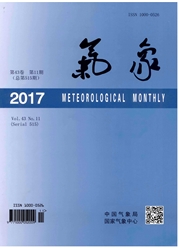

 中文摘要:
中文摘要:
利用地基微波辐射计观测资料,对两次冰雹过程进行观测分析。结果表明:中低层暖湿气流输送、中层干冷空气侵入,在0~10km形成“上干、下湿”2层垂直分布结构。低层的感热和潜热随上升气流向上输送,2~3km层明显增温,0、5和-20℃层略微上升。同时,低层水汽也随上升气流向上输送,降雹前大气液态水总含量(II.W,下同)和大气水汽总含量(1wV,下同)及过冷水含量快速增长。水汽经过冷层后,冰晶增多增大。当冰晶增大落人OC以上区融化层时,冰晶融化导致液态水增加,一部分形成冰雹或地面降水,导致降雹之后ILw、1wV及OC以下液态水含量减小。上述结论对冰雹的预警有一定指示意义。
 英文摘要:
英文摘要:
Using ground-based microwave radiometer observation data, two hailstorm cases that happened in Xianning of Hubei Province on 26 February 2009 and 12 April 2010 are analyzed. The results show that low-level warm air transportation and mid-level dry cold air intrusion contributes to the "upper dry and lower wet" 2-layer vertical structure of 0--10 km relative humidity. The updraft transports upward sensi ble heat and latent heat of the low level, resulting in the significant warming of 2--3 km layer, and the slight rising of 0, --5 and --20~C layers. As the low-level moisture is rising up, ILW, IWV and super- cooled water grow rapidly before the hail. After the wet vapor goes through the cold layer, the ice crystals increase. When the ice crystals increase and fall into the area above 0℃ melting layer, the ice crystals are melted, leading to an increase in liquid water, and part of the water becomes hails or surface precipitation, so that the ILW, IWV and liquid water content below 0℃ decrease after hails. The above conclusion is of some significance to the early warning of hails.
 同期刊论文项目
同期刊论文项目
 同项目期刊论文
同项目期刊论文
 期刊信息
期刊信息
